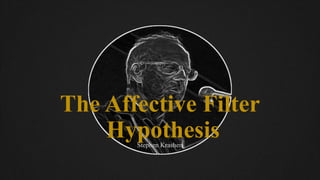EL116-GROUP5.pptx
•Download as PPTX, PDF•
0 likes•9 views
The document discusses Stephen Krashen's Affective Filter Hypothesis, which proposes that affective variables like motivation, self-confidence and anxiety play a role in second language acquisition. Specifically, it states that learners with high motivation, self-confidence and low anxiety are better equipped for success, while those with low self-confidence and high anxiety experience a "mental block." It concludes that language pedagogy should aim to not only provide comprehensible input but also create a low-anxiety environment to encourage language acquisition.
Report
Share
Report
Share

Recommended
Eduardo HernandezAffective effective language english language teaching method

Affective effective language english language teaching methodEduardo Hernández Rangel, MCC, PMP, ITIL Cer, Scrum Master
https://app.box.com/s/h5mhqoyabotgw05s0df0ltw3e39pgnmyTỔNG HỢP HƠN 100 ĐỀ THI THỬ TỐT NGHIỆP THPT TOÁN 2024 - TỪ CÁC TRƯỜNG, TRƯỜNG...

TỔNG HỢP HƠN 100 ĐỀ THI THỬ TỐT NGHIỆP THPT TOÁN 2024 - TỪ CÁC TRƯỜNG, TRƯỜNG...Nguyen Thanh Tu Collection
More Related Content
Similar to EL116-GROUP5.pptx
Eduardo HernandezAffective effective language english language teaching method

Affective effective language english language teaching methodEduardo Hernández Rangel, MCC, PMP, ITIL Cer, Scrum Master
Similar to EL116-GROUP5.pptx (20)
Affective effective language english language teaching method

Affective effective language english language teaching method
109Learning OutcomesBy the end of this chapter you will 

109Learning OutcomesBy the end of this chapter you will
109Learning OutcomesBy the end of this chapter you will 

109Learning OutcomesBy the end of this chapter you will
Recently uploaded
https://app.box.com/s/h5mhqoyabotgw05s0df0ltw3e39pgnmyTỔNG HỢP HƠN 100 ĐỀ THI THỬ TỐT NGHIỆP THPT TOÁN 2024 - TỪ CÁC TRƯỜNG, TRƯỜNG...

TỔNG HỢP HƠN 100 ĐỀ THI THỬ TỐT NGHIỆP THPT TOÁN 2024 - TỪ CÁC TRƯỜNG, TRƯỜNG...Nguyen Thanh Tu Collection
This presentation was provided by William Mattingly of the Smithsonian Institution, during the fifth segment of the NISO training series "AI & Prompt Design." Session Five: Named Entity Recognition with LLMs, was held on May 2, 2024.Mattingly "AI & Prompt Design: Named Entity Recognition"

Mattingly "AI & Prompt Design: Named Entity Recognition"National Information Standards Organization (NISO)
Recently uploaded (20)
TỔNG HỢP HƠN 100 ĐỀ THI THỬ TỐT NGHIỆP THPT TOÁN 2024 - TỪ CÁC TRƯỜNG, TRƯỜNG...

TỔNG HỢP HƠN 100 ĐỀ THI THỬ TỐT NGHIỆP THPT TOÁN 2024 - TỪ CÁC TRƯỜNG, TRƯỜNG...
DEMONSTRATION LESSON IN ENGLISH 4 MATATAG CURRICULUM

DEMONSTRATION LESSON IN ENGLISH 4 MATATAG CURRICULUM
Trauma-Informed Leadership - Five Practical Principles

Trauma-Informed Leadership - Five Practical Principles
Spring gala 2024 photo slideshow - Celebrating School-Community Partnerships

Spring gala 2024 photo slideshow - Celebrating School-Community Partnerships
How to Send Pro Forma Invoice to Your Customers in Odoo 17

How to Send Pro Forma Invoice to Your Customers in Odoo 17
UChicago CMSC 23320 - The Best Commit Messages of 2024

UChicago CMSC 23320 - The Best Commit Messages of 2024
When Quality Assurance Meets Innovation in Higher Education - Report launch w...

When Quality Assurance Meets Innovation in Higher Education - Report launch w...
Major project report on Tata Motors and its marketing strategies

Major project report on Tata Motors and its marketing strategies
Mattingly "AI & Prompt Design: Named Entity Recognition"

Mattingly "AI & Prompt Design: Named Entity Recognition"
EL116-GROUP5.pptx
- 1. The Affective Filter Hypothesis Stephen Krashen
- 2. At the end of this lesson students will be able to: • Define Affective Filter Hypothesis. • Analyze the variables that affect in second language acquisition. • Formulate Examples • Apply what you have learned. OBJECTIVES:
- 3. • The term “Affective Filter” originates from Stephen Krashen, an expert in the field of linguistic, who described it as a number of affective variables that contribute to second language acquisition. • Krashen (1986) cites motivation, self-confidence, and anxiety in the Affective Filter Hypothesis as three categories of variables that play a role in second language acquisition
- 4. • Affective Filter Hypothesis embodies Krashen’s view that number of affective variable’s play a facilitative, but non causal role in second language acquisition. • The Affective filter can be either ‘high’ or ‘low’, ‘up’ or ‘down’. If a child’s filter is up, they are feeling pressured, concerned, and distracted by negative emotions. If the filter is down, we have a relaxed pupil who is in their element, absorbing information and being productive.
- 5. • Learners with a low affective Filter; high motivation and self- confidence and a low level of anxiety are better equipped for success in SLA. • Learners with a high affective Filter; low self-confidence and high level of anxiety form a mental block. When Filter is high it blocks language acquisition. • Affective Filter Hypothesis implies that our pedagogical goals should not only include supplying comprehensible input, but also creating a situation that encourage a low filter.
- 6. Examples in the Classroom NEGATIVE FEELINGS POSITIVE THOUGHTS
- 7. Application for Teaching • In any aspect of education, it is always important to create a safe, welcoming environment in which students can learn. In language education this may be especially important since in order to take in and produce language, learners need to feel that they are able to make mistakes and take risks. • It is important for a teacher to build an environment with low affective filter where students can be able to participate without feeling anxious. • Strengthening students’ confidence and reducing their anxiety.